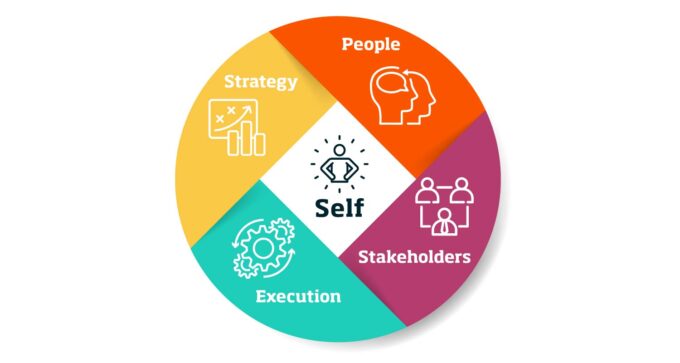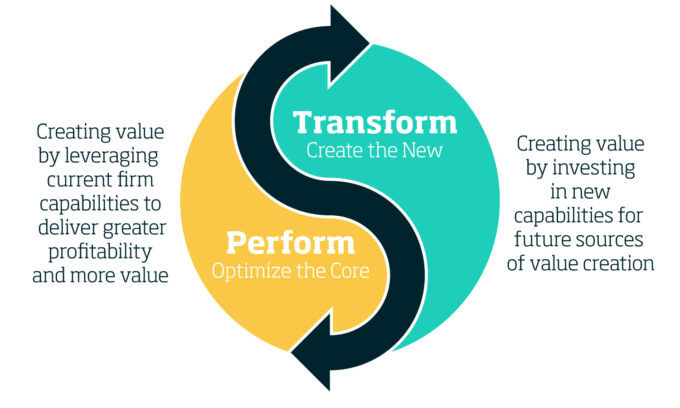
How to win over DE&I doubters and disruptors
Effective DE&I strategies are proven to enhance performance, yet they still face resistance – perhaps now more than ever. Here’s how to convince the naysayers....
Audio available

by Tania Lennon Published January 8, 2025 in 2025 Trends • 10 min read
The business world in 2025 will likely face continued disruption fueled by geopolitical and financial uncertainty, rapid technological change, and the effects of climate change. Leaders will need to change long-established strategies and explore different ways to motivate their teams if they are to steer a steady course through the chaos.
According to the Accenture 2024 Pulse of Change Index – which quantifies the change companies face across six factors: technology, talent, economic, geopolitical, climate, consumer, and social – business leaders faced the highest-ever levels of change in 2023 and expect it to accelerate. Overall, the index suggests that the rate of change has increased 183% over the past four years and 33% in 2023 alone.
Ongoing uncertainty and complexity are compounded by the increasing rate of disruption. According to Bill Fischer, Professor Emeritus of Innovation Management at IMD, it is essential to distinguish between change and disruption. Disruption is characterized by discontinuity in businesses, markets, and ecosystems as a result of change.
“Disruption is an outcome, not a strategy,” he says. “It is a rupture in the present trajectory of an industry’s growth.” This has important implications for leaders seeking to create value. The traditional approach to strategic planning for value creation is logical, systematic, and data-driven, leveraging existing data as a base for anticipating trends. However, in a world characterized by disruption, relying solely on rational means informed by historical data will likely leave organizations vulnerable.
As the pace of disruption increases, leaders need to adopt new mindsets and capabilities to enable them to chart a path ahead. Research by IMD’s Strategic Talent Lab in partnership with our Center for Future Readiness, World Competitiveness Center, and the TONOMUS Global Center for Digital and AI Transformation has provided key insights into the capabilities needed for leaders to create value in this challenging environment.
Our talent diagnostics have identified five key behaviors that leaders who sustain success in a dynamic and turbulent environment tend to put more focus on. These are mapped against the five core demands of the leader role – strategy, execution, stakeholders, people, and self. What can you do in 2025 to enable leaders to thrive in 2025?

We are prone to fall into patterns of behavior and habits. Our energy-conscious brains seek to move things from System 2, which requires conscious effort and focus, to System 1, which is efficient and almost automatic because we stop thinking about it.
The same patterns are observed at a strategic level. Clayton M Christensen’s original work on disruption predicted that market leaders would be least likely to adapt and, therefore, most prone to the effects of disruption. According to Fischer, this pattern is readily observable today and often results in wholesale displacement of the existing cohort of previously successful, market-leading firms. For example, in the telecoms sector, think about how the market leaders such as Nokia, Ericsson, Motorola, and Blackberry were caught by surprise by sudden and dramatic shifts in the market, resulting in their near disappearance. Fischer says that disruption typically comes from outside the core competitive set within an industry. “Disruption is almost always authored by organizations outside the traditional mix and is often invisible to the prevailing market leaders,” he adds.
According to Accenture’s 2024 Pulse of Change Index, the two biggest drivers of change are digital/AI and talent, which are transforming people, technology, and talent. This shift offers an opportunity to go beyond reactive integrations of these change drivers to transform business models. Business model innovation provides the greatest source of market disruption, customer choice, and competitive advantage.
“Leadership is about choices,” says Fischer. “We shouldn’t be casual about the choices we make. All too often, I see a great deal of casualness in the way business model innovation and organizational transformation is regarded.” He advocates using tools like the Business Model Canvas to shape a path from business model innovation to implementation. The template also allows for emergent features of strategy shaping by considering the wider ecosystem in which leaders are operating, including customers, employees, and stakeholders. The new year may be the time to fundamentally rethink how you do business, exploring a wider range of choices and questioning core assumptions.
Organizations that can switch between a rigorous focus on optimizing current capabilities to drive profitability today – what we call Perform – while also laying the foundations for tomorrow’s revenue streams through ongoing innovation – what we call Transform – are much better positioned to sustain success in the context of increasing disruption.
In the context of heightened disruption and uncertainty, focusing only on current business performance is insufficient to sustain success. “Businesses are experiencing a series of seismic shifts as a result of global developments and must stay on top of industry trends to prosper,” says Howard Yu, LEGO Professor of Management and Innovation at IMD. “Leaders must navigate rapid and frequent changes, enabling them to overcome challenges, foster innovation, and prosper amidst uncertainty.”

Organizations that can switch between a rigorous focus on optimizing current capabilities to drive profitability today – what we call Perform – while also laying the foundations for tomorrow’s revenue streams through ongoing innovation – what we call Transform – are much better positioned to sustain success in the context of increasing disruption.
This finding is replicated in our research on the changing demands on leaders from the IMD Strategic Talent Lab. Research by Professors Misiek Piskorski and Ric Roi found that leaders who thrived in environments characterized by disruption, complex challenges, and increasing dynamism demonstrated the ability to move between two different modes of operation.
This ability to move between Perform and Transform, Today and Tomorrow, is known as leader ambidexterity – an idea that surfaced from research by Kathrin Rosing, Michael Frese, and Andreas Baush on the impact of leadership on innovation. It reflects the need for leaders to constantly switch and adapt their approach to leading, both strategically and behaviorally. As Piskorski says, “Winning organizations have senior leaders who are ambidextrous and can adapt their behaviors to adopt the optimal approach to create the most value for the organization given factors such as organizational capabilities, market conditions, competitors, disruption, and emerging technologies. There is no longer one best way to lead.”

With the rate of obsolescence of ideas, products, and capabilities becoming faster as disruption and change accelerate, organizations that thrive are those that can harness insights and ideas more quickly than the competition. The richness and diversity of information that organizations can tap into is key to innovation success. Bill McEvily and Aks Zaheer’s work points to the power of networks as a source of ideas and innovation. Simply put, the broader and more diverse the range of networks that organizations can tap into, the more likely they are to be able to innovate to create a competitive advantage.
The same applies to leaders: those who can integrate and synthesize diverse ideas from a wide range of functions, organizations, and teams are more likely to create innovative solutions to complex problems. However, diversity of ideas is not enough: Anita Woolley’s work on collective intelligence shows that leaders need social sensitivity and listening skills to elicit, encourage, and integrate ideas to truly capitalize on the benefits of diversity.
According to IMD’s Professor Marleen Dieleman, who is an expert on the challenges faced by emerging market enterprises in their strategic trajectories, actively auditing and expanding the range of leader networks can be hugely beneficial. “Broader network connections are an invaluable source of ideas that leaders can tap into – the more diverse, the better,” she says. “In addition, they provide a base that leaders can use to influence others by building momentum and support through their expertise, connections, and the power of their ideas.”
Leaders need to ensure they are well-equipped to lead in distributed environments to create more personalized employee experiences. This means adapting their leadership behaviors to a greater extent than ever before.
Disruption and change are impacting on how we lead people in the workplace. Efforts to counter the growing rates of social isolation reported at work have resulted in polarized swings between the “all in” mandatory return to work and the “you choose” option that empowers employees to choose the best working mode for them. Whatever the mode, leaders need to ensure they are well-equipped to lead in distributed environments to create more personalized employee experiences. This means adapting their leadership behaviors to a greater extent than ever before.
According to Ric Roi, Professor of Leadership and Organization at IMD, this shift toward breadth also influences the core nature of the leader role. “In our work on talent development at IMD, we are seeing fewer specialists advancing to C-suite roles. This is driving a shift from succession planning – where leaders follow a defined path to the top – to progression planning, where talent development aims to provide leaders with a broad range of experiences that spans functions, geographies, and business challenges.”
Based on Roi’s research, breadth of experience is a clear driver of leader effectiveness in disrupted and dynamic environments. “There is a clear correlation between the range of experiences leaders have had – jobs, companies, cultures, strategic challenges – and their propensity to create value by drawing on a range of different choices,” he says. “This makes them more adaptable and able to build more resilient businesses.”
Exposure to a broader range of situations and challenges enables leaders to create more complex mental models. Testing and experiencing leadership in a wider range of environments builds deeper empathy and understanding and provides leaders with the stimuli to expand their repertoire of responses and styles, strategically and behaviorally. This enables leaders to tailor and personalize their leadership to different people and situations, a key factor for success in the distributed leadership model.
According to research by Deloitte, 95% of the C-suite agree that they should accept overall responsibility for employees’ well-being. This means leaders need to exercise self-care in addition to focusing on their people.
Stepping into the unknown is never easy. It requires grit, which is passion and perseverance toward long-term goals, and a growth mindset, which is about how leaders make sense of failure and challenge. Leaders need to be courageous, especially in environments where they cannot rely on data to predict likely futures and where testing, iteration, and learning from failure offer the best route to find an approach that works.
These factors use up personal resources and take a toll on the well-being of leaders and team members. According to research by Deloitte, 95% of the C-suite agree that they should accept overall responsibility for employees’ well-being. This means leaders need to exercise self-care in addition to focusing on their people.
For Alyson Meister, Professor of Leadership and Organizational Behavior at IMD, leaders need to develop and implement an energy-management strategy. Levels of mental and physical energy are fluid and fluctuate over time, especially in the context of turbulence. Leaders who consciously monitor and maintain their energy levels can boost their ability to navigate change and make effective, clear-headed decisions, which has the dual benefit of boosting commercial performance while improving health and well-being outcomes.
Meister suggests that leaders need to develop their own resilience-building strategy. This could involve switching off through non-work-related activities (e.g., reading or cooking, making family time, or taking up a hobby). Other health-promoting measures include taking 10-minute micro-breaks, learning calming breathing techniques, trying meditation, or reconnecting with nature through walks in the park. Knowing how to recover from stress requires self-knowledge and self-discipline and is different for each person.
While there are benefits for the leader and their decisions, these behaviors also provide a powerful signal to others. Leaders’ behavior and emotional states have a direct impact on employees. They are role models – their behaviors are contagious and contribute to setting the culture of the business. Leaders who can exhibit the capacity to push themselves into new and sometimes scary situations, while also attending to their well-being to maintain balance and equilibrium, will be ideally placed to navigate the challenges of 2025.

Executive Director of the Strategic Talent Development initiative
Tania Lennon leads the Strategic Talent team for IMD. She is an expert on future-ready talent development, including innovative assessment methods to maximize the impact of talent development on individual and organizational performance. Lennon is a “pracademic”, blending a strong research orientation with evidence-based practice in talent development and assessment.

May 22, 2025 • by Josefine van Zanten, Luca Condosta in 2025 Trends
Effective DE&I strategies are proven to enhance performance, yet they still face resistance – perhaps now more than ever. Here’s how to convince the naysayers....
 Audio available
Audio available
April 22, 2025 • by D W Pine in 2025 Trends
Responsible for TIME magazine’s iconic covers, D W Pine explores his creative process and shares insights on how to cut through the noise and make an impact....

February 7, 2025 • by Carlos Cordon in 2025 Trends
President Trump will be erratic, warns IMD’s Carlos Cordon, so supply chain leaders must be prepared to work with what he gives them...

February 3, 2025 • by Natalia Olynec in 2025 Trends
Warnings about alcohol’s harms by medical experts are nothing new. But the drinks industry is now taking sobriety seriously by investing in a growing range of alternative products....
Explore first person business intelligence from top minds curated for a global executive audience